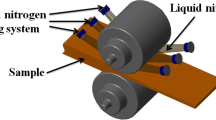Conclusions
-
1.
The plasticity of brass LMtsZh 55-3-1 at high temperatures depends on the original condition.
-
2.
Quenching sharply reduces the plasticity when the brass is straightened in the heated condition.
-
3.
To prevent the negative effect of quenching before straightening, the propeller must be annealed in a furnace or the section of the blade must be annealed.
Similar content being viewed by others
Literature cited
Itidzi Nakano, "Overhauling ship propellers," Amagasaki Seitetsu Gikho, 13 (1964).
G. Callis, Shipbuilder and Marine Engine Builder, 3–5 (1963).
B. P. Aravin et al., "Correcting defects and damage of screw propellers made of copper alloys," Tekhnologiya Sudostroeniya, 7 (1971).
A. A. Presnyakov and G. N. Nysynbaev, "Effect of original condition on properties of alloys L59 and LS 59-1," Izv. Akad. Nauk SSR, 3 (12) (1961).
V. I. Zhuravlev et al., "Characteristics of manufacturing and overhauling screw propellers of various metallic materials," Tekhnologiya Sudostroeniya, 3 (1965).
Additional information
S. Ordzhonikidze Sevastopol' Marine Factory. Translated from Metallovedenie i Termicheskaya Obrabotka Metallov, No. 1, pp. 68–70, January, 1974.
Rights and permissions
About this article
Cite this article
Sagan, V.Y. Plasticity of LMtsZh 55-3-1 brass at high temperatures. Met Sci Heat Treat 16, 75–77 (1974). https://doi.org/10.1007/BF00679210
Issue Date:
DOI: https://doi.org/10.1007/BF00679210




